A History of HMS FENCER
|
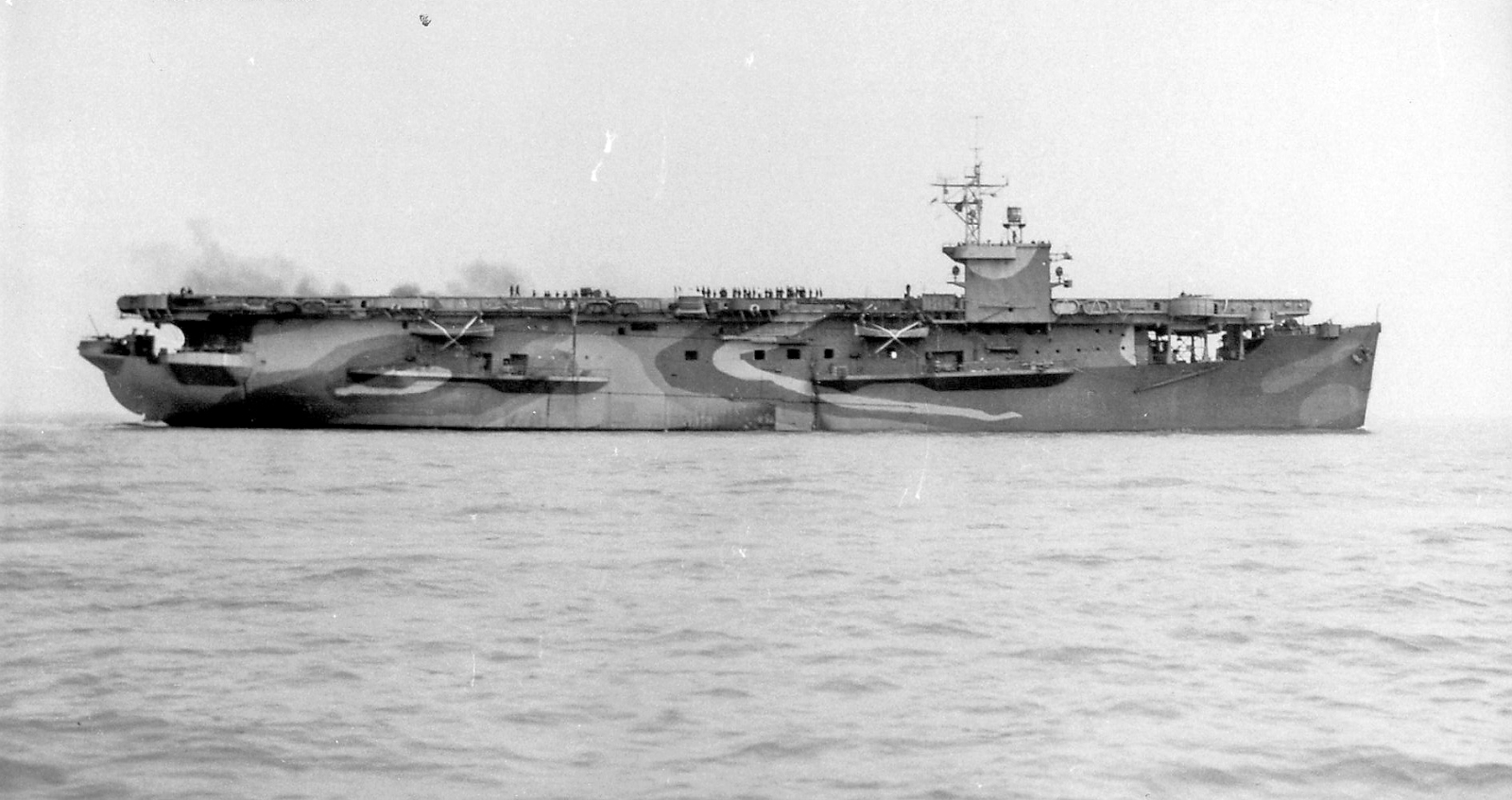 |
Starboard broadside view of HMS FENCER ACV 14 taken on
March 26th 1943 during her builder's sea trials off San
Francisco. |
Her keel was laid down September 5th 1941, by the Western Pipe and Steel Co., San Francisco, California as Maritime Commission C3-S-A2 type freighter, hull number 197, Western Pipe and Steel hull number 77. While under construction the hull was purchased by the US navy to be the USS CROATAN, AVG-14. She was launched on April 4th 1942 and the hull was towed to the Mare Island Naval Shipyard, Vallejo California to be completed and fitted out as an Auxiliary Aircraft Carrier. Whilst still under construction it had been decided that ACV- 14 was to be transferred to the Admiralty, on loan under the Lend-Lease scheme on her completion. She was the third of four vessel built for completion as an auxiliary aircraft carrier by Western Pipe and Steel for transfer to the Royal Navy, the other three were -
ATTACKER (ex USS BARNES),
STALKER (ex USS HAMLIN), and
STRIKER (ex USS PRINCE WILLIAM). Her build was completed on February 20th 1943 having taken a total of 534 days, 212 days on the ways and 323 days afloat.
On completion of defect rectification and final fitting out, ACV-14 was officially delivered to the US Navy at Mare Island on February 20th 1943 and commissioned into USN service as the USS CROATAN. She decommissioned and transferred to Admiralty custody on February 27th 1943 alongside at Pier 26 in San Francisco, under the San Francisco–Oakland Bay Bridge.
|
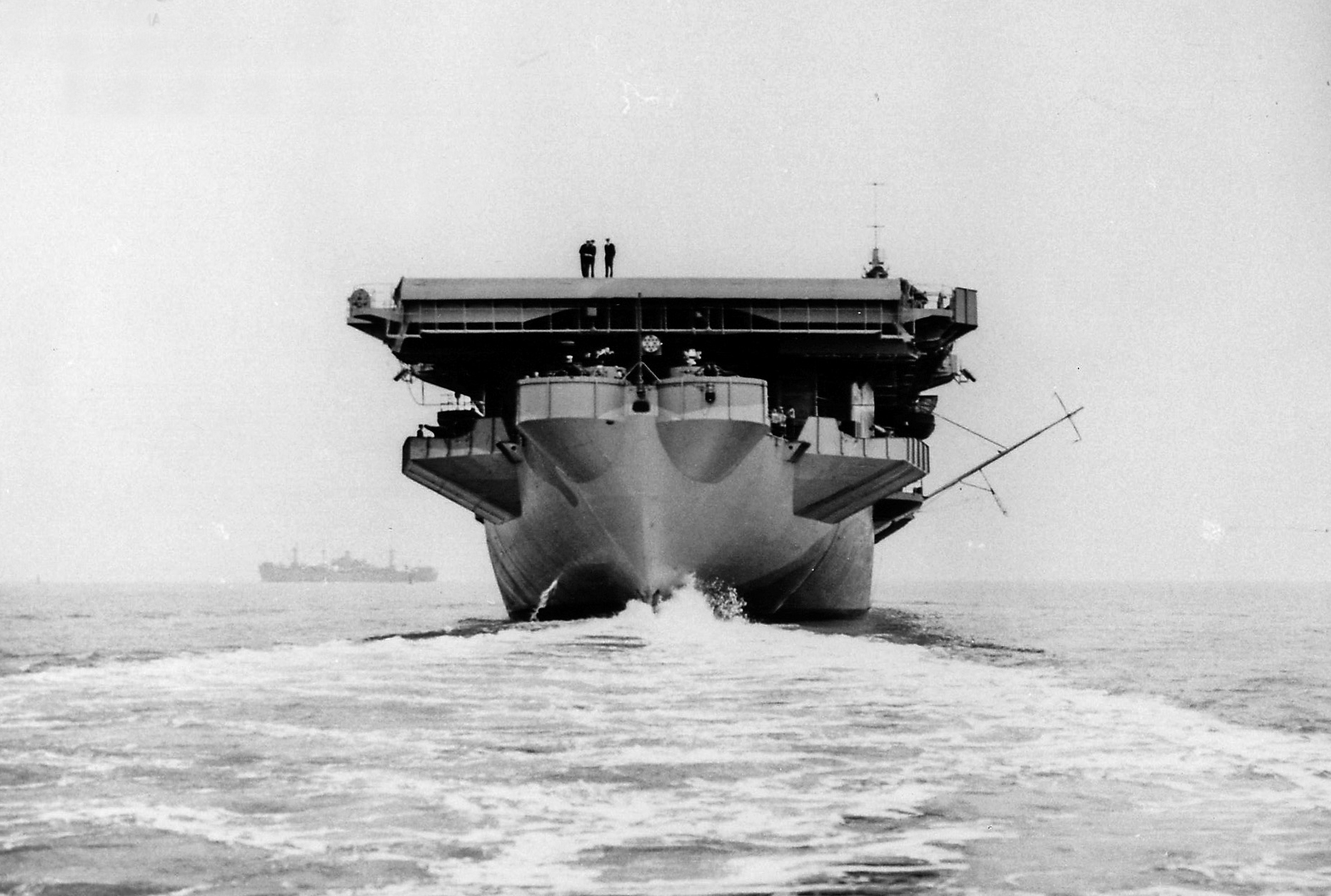 |
Stern view of HMS FENCER ACV 14 taken on March 26th 1943
during her builder's sea trials off San Francisco. |
A Royal Navy commissioning crew had begun to arrive in San Francisco from New York during May 1942, and was under the command of Cdr. C. N. Lentaigne RN. While waiting for the ship to be completed they attuned courses to prepare them for operating the American equipment on-board; for example specialist training in the use of ASDIC equipment was given at the U S Navy Patrol Force Anti-Submarine Training Unit. CV-14 commissioned into RN service on March 1st 1943 as HMS FENCER (D64), Captain E. W. Anstice RN in command.
A Royal Navy commissioning crew had begun to arrive in San Francisco from New York during May 1942, and was under the command of Cdr. C. N. Lentaigne RN. While waiting for the ship to be completed they attuned courses to prepare them for operating the American equipment on-board; for example specialist training in the use of ASDIC equipment was given at the U S Navy Patrol Force Anti-Submarine Training Unit. CV-14 commissioned into RN service on March 1st 1943 as HMS FENCER (D64), Captain E. W. Anstice RN in command.
She sailed from San Francisco on March 30th to begin her Admiralty sea trials and calibration runs followed by Gunnery exercises and RDF trials off the California coast. These were completed on April 1st and she returned to her berth for defect rectification and to complete storing ship in preparation for departure.
Passage to the UK: April 1943
FENCER sailed from San Francisco on April 5th bound for Balboa on passage to Norfolk, Virginia, she arrived at Balboa on the 15th. After passage through the Panama Canal she sailed from Cristobal on April 18th, securing alongside at Norfolk Navy Yard at 14:45 on the 24th. Here she was taken in hand by the dockyard for the installation of radio direction finder equipment, work to straighten the ammunition hoist cage and install additional stiffening, boom and deck drains. Made repairs to leaking port boilers, pitometer log and siren. This work was completed by the 27th and she left her mooring at 16:00 to come alongside at the Naval Operating Base. Her she embarked a ferry load of American airframes and store for delivery to the UK. She sailed for New York on May 1st. On arrival at New York on May 4th she was moored alongside at at Pier #86. North River for voyage repairs which were carried out by Todd Erie Basin Drydocks, Inc., the work was completed the following day. FENCER now prepared to join the UK bound convoy HX.238 which departed from New York on May 7th for Liverpool. After an uneventful Atlantic crossing FENCER and the convoy arrived at Liverpool on the 22nd.
Modification and working up: June – October 1943
After unloading her ferry load FENCER was taken in hand by a commercial shipyard on the Mersey for a two month period of modification to bring her to RN standards before entering full service. This work included lengthening the flight-deck to allow Swordfish aircraft to take off with a full weapons and fuel load, installing British Type 79B aircraft warning and Type 272 surface search radars, replacing the US 5in gun mountings with British model, and modification of her petrol distribution system. On completion of her post modification shake-down she sailed for the Clyde on July 31st to begin work-up for operational service.
On August 5th she embarked the 9 Swordfish and 6 Seafires of 842 Squadron from
RNAS Belfast to begin her flying work-up in the Clyde training areas. There are two recorded deck crashes during this period; on August 12th Sub-Lt J. A. Metcalf, RNVR flying in Swordfish HS329 ('F') buckled the fuselage on landing, and on the 19th Sub-Lt I. D. Kelsell, RNVR in Seafire MB373 touched the barrier landing, this resulting in the fuselage skin being wrinkled.
|

 |
Aircraft of 842 squadron operating form FENCER. Left. a
swordfish has hit the island after a barrier crash.
Right, A Seafire lands on. |
Operation ALACRITY: September – October 1943
In late September FENCER was allocated for service with the 8th Escort Group (destroyers INCONSTANT, VISCOUNT, WHITEHALL, WRESTLER, and Free Polish GARLAND and BURZA) for trade protection duties in the Atlantic. Her first outing was to be as part of the covering force for Operation ALACRITY, the ferrying of RAF assists to the Azores. On September 25th she embarked additional aircraft, 6 Walrus and 4 Swordfish that formed 700 ‘W’ flight to increase her anti-submarine (A/S) capabilities and sailed with the 8th Escort Group. They joined Escort Group B5 (destroyers HAVELOCK, VOLUNTEER and WARWICK, corvettes BUTTERCUP, LAVENDER and GODETIA, and sloop LOWESTOFT) to escort a special convoy from the UK to the port of Angra do Heroism, Terceira Island, in the Azores carrying the men and equipment of Coastal Command No. 247 Group Royal Air Force which were to setup flying operations on the Azores Islands of Fayal and Terceira.
The ALACRITY convoy arrived at Angra do Heroism on October 8th, FENCER had already disembarked some of her aircraft to Lagens airfield on Terceira on the 6th , the first RAF aircraft, Flying Fortresses, were expected soon but bad weather delayed their departure from Gibraltar so RN Swordfish commenced anti-submarine patrols. The First Fortresses arrived on the 18th but 842 sqn remained ashore until October 24th.
There were two Seafire accidents during this period; on the 8th Sub-Lt A. Sachnovsky, RNVR made a fast approach to land on FENCER in NX911 resulting in the aircraft being damaged. The first Seafire to land at Lagens, was PAl20 Sqn ('P') flown by Sub-Lt Kelsall on the 10th, he managed to hit a haystack but the aircraft suffered no damage. Two Swordfish were lost during operation ALACRITY, on October 7th HS623 ('H') ran out of fuel and ditched, the crew Sub-Lt T. D. Merrick, RNVR, Sub-Lt J. B. Simpson, RNVR and Petty Officer Airman R. Morgan were all killed. On the 11th HS661 ('D') ditched after failing to achieve sufficient flying speed on take-off armed with 8 Rocket projectiles (RP) and stalled into the sea, the crew Lt. L. R. Chadwick, RNVR, Sub-Lt D. W. Glassborrow, RNVR and Naval Airman M. A. Thackeray were safely rescued.
On release from Operation ALACRITY FENCER and 8th Escort Group sailed to rendezvous with the east bound convoy SC.145 from Halifax, air cover was provided from October 29th until November 2nd. On the 1st Swordfish LS191 ('A') flown by Sub-Lt H. G. Boniface, RNZNVR was damaged on returning from patrol, the aircraft stalled over a pitching deck and struck the island.
She then proceeded to the Clyde, arriving on the 5th. On November 6th the four Wildcats of 1832A fight from RNAS Maydown, Northern Ireland to supplement her fighter complement. One of these new additions was lost on November 20th while attempting to land on FENCER off Ailsa Craig JV385 flown by Sub-Lt J. M. Kay, RNVR stalled and hit the rounddown before falling into the sea and sank, he was not recovered. 700 ‘W’ disembarked to
RNAS Machrihanish on November 19th.
|
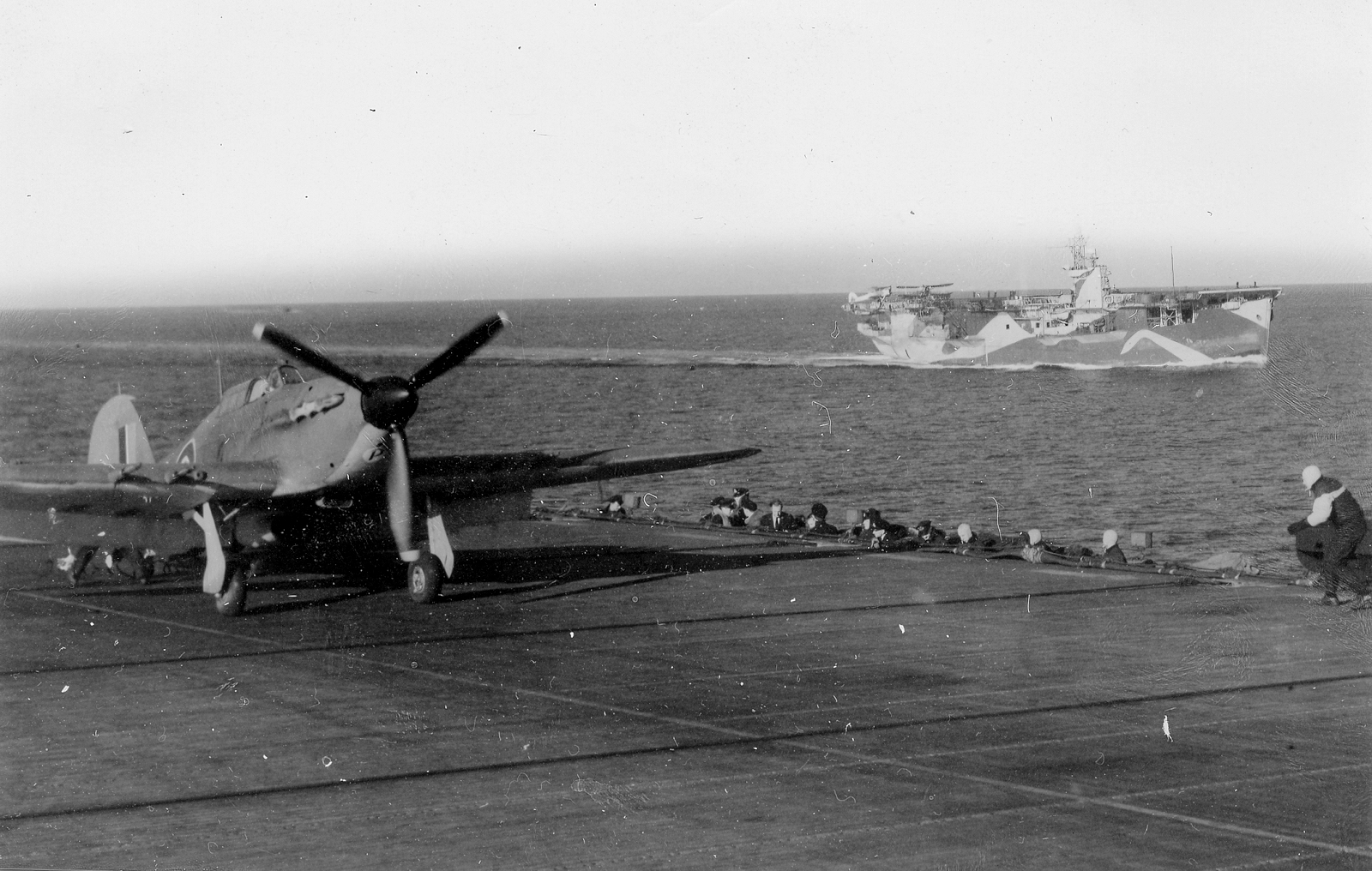 |
FENCER seen from the flight deck of her sister
CVE STRIKER during operations in the Atlantic.
Photo: Richard Webb |
Convoy escort duties November
Her next convoy cover was the combined OS.60/ KMS.34 which departed Liverpool on November 25th bound for Gibraltar, FENCER began A/S sweeps from the 26th , remaining with it until December 5th when she switched to cover the UK bound combined convoy SL.141/MKS.32 from the 6th to the 11th.
She now switched to cover the south bound combined convoy OS.61/ KMS.35 which departed Liverpool on December 8th. She covered this convoy from the 11th tie the 16th.
On December 1st her new Wildcat fighters had their first successful interception; JV344 ('FY') flown by Lt L. C. Wort, RNVR and JV427 ('FW') flown by Lt R. A. Fleischmann-Allen, RNVR shot down a Fw200 German reconnaissance plane after setting its starboard engine on fire, it was seen to break up in flames, and two survivors were observed in the sea at position 48°30' N 18°30' W.
On December 19th while on passage to the Clyde Seafire PA100 ('D') flown by Sub-Lt Sachnovsky drove off a Fw200 at 08:45 in position 45°08' N 18°53' W, although fired upon no damage was seen.
Under repair
On arrival on the Clyde she entered a dockyard for repairs on the 24th. The work was to take five weeks; after completion of post refit trials she was deployed with 16th Escort Group resumed Atlantic convoy defence duties. There were two Seafire accidents on February 5th, both aircraft were flown by Sub-Lt E. R. Bennett, RNVR; he entered the barrier in PAl20 and crashed on landing and ditched overboard in NX985, and was rescued by the plane guard
Destroyer.
FENCER was to cover the passage of 5 convoys during February 1944; the first was ON.223 bound for New York, she briefly covered its passage on the 10th & 11th. On joining the convoy one of the carriers Swordfish attacked and sank U-666, Swordfish LS368 ('A') made an attack using aerial depth charges in position 53°56' N 17°16' W the pilot, Sub-Lt W. H. Thomson, RNVR was awarded the DSC for this action.
FENCER next switched to cover the in-bound HX.278 joining them on the 15th, remaining with them until the 19th. She next joined Convoy KMF.29 which had departed from the Clyde for Alexandria on 21 February, covering this from late on the 21st until the 26th when she switched to the combined north bound Convoy SL.149/MKS.40, escorting this until the 31st when she detached and proceeded to the Clyde.
Reallocated for operations with the Home Fleet; March 1944
FENCER remained on the Clyde until she sailed for Scapa Flow on March 17th
1944, arriving there the following day. 842 squadron now carried 12 Swordfish and 8 Wildcats, the remaining 3 Seafires departed and ‘E’ flight of 1832 squadron joined as FENCER sailed from the Clyde. She was now allocated to participate in Operation TUNGSTEN, specifically to provide an A/S element to the force.
Operation TUNGSTEN forces left Scapa on March 30th in two groups; Force 1 comprised Battleships DUKE OF YORK and ANSON, Fleet Carrier VICTORIOUS, Cruiser BELFAST, and 5 destroyers left Scapa early morning and after conducting brief exercises proceeded to a position off Bear Island to cover the passage of convoy JW58. Force 2 comprised the Cruiser ROYALIST (Rear Admiral Escort Carriers), the CVEs
EMPEROR, FENCER,
PURSUER,
SEARCHER, Fleet Carrier FURIOUS, Cruisers SHEFFIELD, JAMAICA, 2 oilers, and 5 destroyers left Scapa p.m. and preceded west of the Orkneys.
On April 1st, the date for the operation, which had been April 4th, was advanced 24 hours to take advantage of favourable weather and lack of air reconnaissance of Force 1. Force 1's first screen from Skaalefiord joined Force 2 the following day and on April 1st the two oilers with two destroyers were detached to the oiling position. On April, 2nd ANSON, VICTORIOUS, BELFAST, and 4 destroyers were detached from Force 1 and joined Force 2. The TUNGSTEN force then steered for the flying off position. Flying conditions were perfect when the flying off position was reached at 04:00 on the 3rd and the aircraft were flown off according to plan except for the loss of one Barracuda which ditched. 40 Barracudas and 81 fighters took part in the two strikes and a further 25 fighters and 9 Swordfish were kept for the defence of the Fleet.
The good weather allowed for the two strike forces to obtain their desired heights and to take the best route over the mountains. No enemy aircraft were seen by the strike aircraft or the Fleet and the flak around the TIRPITZ was much less than anticipated. The attack was carried out by both fighters and bombers; fighters strafing the defences from a low height and bombers pressing home an accurate attack. The losses during the attack were remarkably small. One Barracuda was shot down over the target and another by shore batteries, both after dropping their bombs. A third Barracuda was lost taking off from VICTORIOUS and a Hellcat ditched when unable to land on
EMPEROR. Both strikes returned and landed on safely with the exception of the one Hellcat. The question of repeating the attack the next day was considered but owing to fatigue of the air crews and serious damage reported to TIRPITZ this was abandoned and the force withdrew to the westward. FENCER’s Swordfish patrols failed to find any U-Boats and she arrived back at Scapa on the 6th, 842 being put ashore to
RNAS Grimsetter.
On the 11th FENCER embarked the 22 Wildcat fighters of 881 squadron in preparation for Operation PITCHBOWL; their parent carrier
SEARCHER had been sent to Rosyth to undergo repairs after operation TUNGSTEN and the loss of her 22 fighters would have been a big shortfall for the next operation which did not require an A/S carrier.
Operation PITCHBOWL called for the provision of fighter protection to RAF Beaufighters operating in two strikes against shipping in the Norwegian Leads provided by three CVES of the Home Fleet. The force, comprising of ROYALIST (Rear Admiral Escort Carriers) CVEs
EMPEROR,
PURSUER, FENCER, Cruisers BERWICK, and SHEFFIELD, escorted by Destroyers MUSKETEER, METEOR, MARNE, MATCHLESS, ONSLAUGHT, PIORUN, and SIOUX, sailed on the 13th, for the flying off position 62°00’ N, 2°30’ E.
Visibility was poor throughout the day and no flying took place. On the following day, the first RAF strike was postponed owing to weather and the force reversed its course. There was no improvement in the weather by the afternoon of the 14th and the first RAF strike was cancelled. The following morning was the same and the operation was abandoned. The force returned to Scapa arriving p.m. on 15th.
SEARCHER arrived back at Scapa in the afternoon and 881 flew back on board. FENCER was next allocated to participate in Operation FZ.
Operation FZ was the codename given to escorting a convoy from northern Russia to the UK. 842 re-joined FENCER on
April 18th from
RNAS Hatston, Wildcat JV527 ('S') flown by Sub-Lt R. P. Gibson. RNVR missed all the wires and entered the barrier joining the ship. The Force comprised of the Cruiser DIADEM (Rear Admiral Commanding, First Cruiser Squadron), Escort Carriers ACTIVITY (833 Sqn - 3 Swordfish & 7 Wildcats) and FENCER (12 Swordfish & 8 Wildcats), transport NEA HELLAS, Destroyers MILNE, MUSKETEER, MATCHLESS, METEOR, ULYSSES, VERULAM, VIRAGO, INCONSTANT, WHITEHALL, WALKER, KEPPEL, WRESTLER, WESTCOTT, GROU, OUTREMONT, WASKESIU, and CAPE BRETON left Scapa on the 19th for Kola Inlet.
The warships all arrived at Kola Inlet on the 24th after an uneventful passage, ACTIVITY lost two Swordfish, the first lost its hook while attempting to land on after a patrol and went over the side on the 22nd, the other ditched in the sea when it discovered that its hook was defective on the 24th, the Canadian Destroyer WKSKESIA rescued the crews of both aircraft.
The ships of the escort Force were to bring Russian and US naval personnel from Murmansk to the UK. 346 officers and men of the USS MILWAUKEE delivered to Murmansk under lend-lease s in convoy JW.59 and 4 Senior Russian Officers were embarked in the escorts of the convoy, 2,348 Soviet officers and men who were to man ships being transferred from Britain to Russia under the lend-lease scheme at UK ports were embarked in the 45 Merchant ships comprising the convoy. The merchant transport NEA HELLAS was intended as the accommodation for the Russian contingent but had to return to the UK soon after departure due to mechanical problems.
|
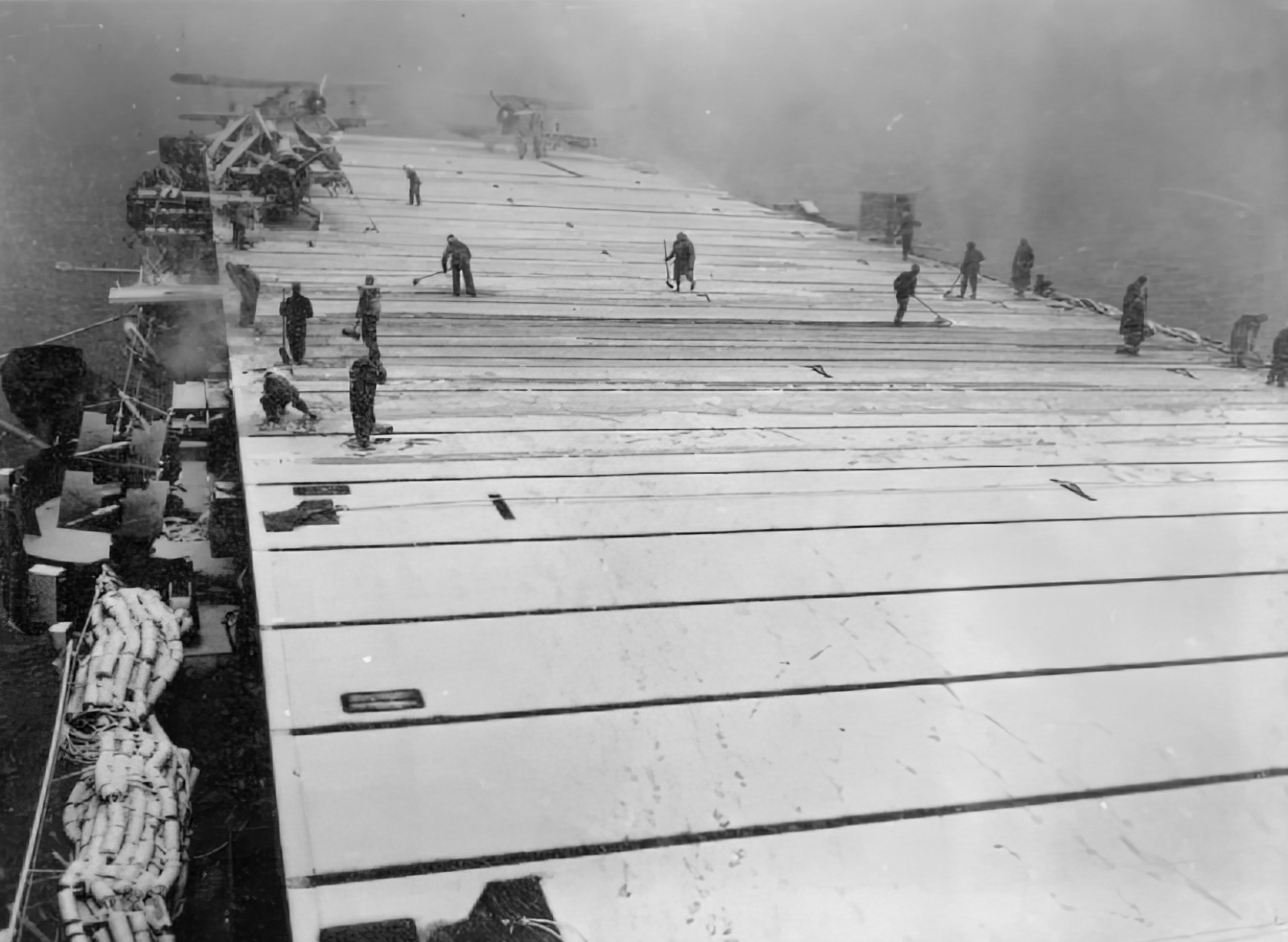
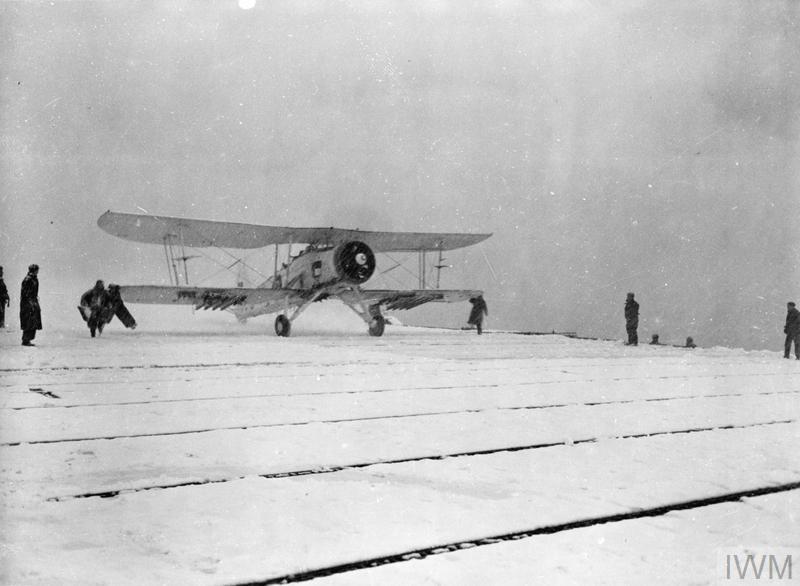 |
Swordfish of 842 squadron operating form FENCER. in
Arctic conditions while escorting convoy RA.59 from
Murmansk to the UK in May 1944. Left clearing the snow
ready for flight operations © IWM (A 23575), right A
Swordfish powers up ready to begin its take off run on
the treacherous deck © IWM (A 23576) |
RA.59 sailed from Kola Inlet on the 28th; the return passage was more eventful, on April 30th Swordfish HS619 ('F') from 842 Sqn made a rocket RP attack on an unidentified U-boat which escaped, and a pair of Wildcats from ACTIVITY’s 833 squadron, FN122 flown by Lt. J. G. Large, RNVR and FN135 flown by Sub-Lt R. K. L. Yeo, RNVR shot down a Ju88 in flames in position 67°0' N 3°9' W. At 19:56 U-307 fired a spread of three torpedoes at the convoy about 50 miles south of Bear Island. The SS WILLIAM S. THAYER in station #33 was hit by two torpedoes on the starboard side, the explosions causing her to split into three sections before sinking.
On May 1st the same two 833 Sqn pilots, now in Wildcats FN135 and JV332, shot down a Bv138 German reconnaissance plane in flames in position 72°20' N 9°13' E. On the same day Swordfish LS369 ('C') of 842 Sqn Sank U-277 by recharges at position 73°24’ N 15°'32' E, the crew, pilot Sub-Lt L. G. Cooper, RNVR, Observer Lt R. V. Barnes RNVR were later awarded DSC, and Petty Officer Airman K. Sutherland awarded the DSM. Swordfish LS280 (833 Sqn) also made a rocket RP attack on an unidentified U-boat which escaped.
Swordfish LS369 ('C') was in action again on May 2nd, this time U-959 was sunk by Rocket Projectiles south-east of Jan Mayen Island, in position 69°20’ N, 00°20’ W, crewed by, Pilot Sub-Lt B. F. Vibert, RNVR was later awarded DSC, Observer Lt E. l. Hutchinson, RNVR and Petty Officer Airman M. A. Thackeray.
On May 3rd FENCER, WALKER, WHITEHALL, and BOADICEA detached from the convoy and proceeded to the Clyde with U.S. and Russian Naval personnel, DIADEM, VERULAM, ULYSSES, and VIRAGO detached to Scapa, also with U.S. Naval personnel. On the 4th ACTIVITY, MILNE, MUSKETEER, MATCHLESS, MARNE, and METEOR detached to Scapa with U.S. Naval personnel. FENCER arrived on the Clyde on May 5th.
She disembarked 842 squadron to
RNAS Machrihanish on the 7th before she entered a commercial dockyard on the Clyde for repairs to storm damage, this was to take a month to complete. She re-embarked her squadron on June 10th and arrived back at Scapa on June 13th.
Operation WANDERERS. This operation was designed to create a diversion in Norwegian waters in the hope of influencing the German navy to retain the large U-boat force already in that area, instead of relocating them south to harass convoys in the English Channel supplying the on-going operation OVERLAORD. The Force, Cruisers ROYALIST (Rear Admiral Escort Carriers) and SHEFFIELD, CVES FENCER and
STRIKER, Destroyers MILNE (D3) METEOR, MUSKETEER, WEESEX, WAKEFUL, and MARNE sailed from Scapa at 06:00 on June 20th. The operation was unsuccessful; no U-boats were sighted. And the Force returned to Scapa on the 25th. The following day half her squadron Swordfish flew ashore to
RNAS Grimsetter, the remainder of the squadron joined them on the 30th.
Re-allocated for Convoy protection duties July – August 1944
A detachment of 6 Swordfish re-embarked on July 5th and FENCER sailed for the Clyde on the 6th. On arrival on the 7th she was transferred to Western Approaches Command for convoy protection duties with the 19th and 40th Escort Groups.
In company with the 19th Escort Group she rendezvoused with the southbound combined convoy
convoy OS.83/ KMS.57 which sailed from Liverpool earlier that day. Air cover was maintained until the 22nd when she switched to cover the northbound combined convoy SL.164/MKS.55, escorting tem until the 29th. There were two landing accidents during this period of convoy protection, both involving Wildcats; On July 15th Sub-Lt R. J. Smyth, RNVR in JV434 landed on a pitching deck burst his starboard tyre causing the starboard upper drag link to be bent, on the 17th Sub-Lt E. E. Ames, RNVR crashed onto a pitching deck in JV596. FENCER then returned to the Clyde on detaching from convoy SL.164/MKS.55 in preparations for Operation CX.
Operation CX was a series of anti-submarine sweeps in the North-Western Approaches. On August 7th FENCER received orders to sail to Stornoway, Outer Hebrides and to disembark 3 of the Swordfish plus squadron personnel and stores to RAF Station
Stornoway. She called at Stornoway on the 8th and returned to Scapa, arriving the following day. She returned to Stornoway on passage to Loch Ewe on the 10th for further detached duty with Western Approaches Command. The remainder of the squadron Swordfish were to join them on August 8th from
RNAS Hatston.
FENCER re-embarked the 842 Swordfish on August 16th only to disembark them again on the 22nd, leaving the ship for the final time.
Loaned to Home Fleet Command
FENCER was now temporarily allocated to Home Fleet Command for Operation TENABLE. On September 27th she embarked an additional 4 Wildcats and 4 Avengers of 852 squadron from RNAS Hatston for the operation. The following day she sailed in company with the Cruiser EURYALUS, CVE
TRUMPETER (846 Sqn 12 Avengers + 4 from 852 Sqn), and Destroyers CAMBRIAN, CAPRICE, CASSANDRA, MYNGS, SAVAGE, and ZAMBESI to lay aerial mines off the Norwegian coast at Ramisoysund, Lepsoyrev, and Harhamsfjord to hamper German coastal shipping. The Force arrived at the flying off point ass planned but the operation was abandoned after the weather closed in preventing any flying and they returned to Scapa on October 5th. The 852 detachments disembarked on the 7th.
|

 |
Aircraft of 852 squadron operating form FENCER. Left.
Avengers, Right a Wildcat is catapulted from the deck.,
TRUMPETER can be seen in the background. |
She next sailed on October 13th for Operation LYCIDAS, a repeat off the abandoned TENABLE employing the same Force. The 852 Sqn detachments re-embarking in FENCER on the 10th and
TRUMPETER on the 13th. On October 15th the Avengers laid mines off Åramsund, and Sado as a result of a navigational error. Mines were also sown in the designated area during the following day. The Force arrived back at Scapa on the 17th and the 852 Sqn detachments left the ship before she sailed again for the Clyde were she arrived on the 18th. The following day the Wildcats of 842 Sqn transferred to HMS CAMPANIA.
Allocated to the British Pacific Fleet: Ferry voyage to Australia November 1944 – January 1945
On completion of unloading the personnel and equipment of 842 squadron FENCER sailed for Liverpool and was berthed at King George V dock where she was joined by her sister CVE
STRIKER on October 25th. The two carriers were to embark the 27 Mosquitoes, 24 B.IVs and 3 PR.XVI, of 618 Squadron RAF; these aircraft together with their equipment and stores, were to be ferried to Australia. The aircraft were hoisted onto the flight deck by floating crane, the personnel of 618 Squadron embarked on October 30th, half in each carrier. On completion of loading the two carriers proceeded to the Clyde.
618 Squadron was a specialist unit for the delivery of the 'Highball' anti-shipping bouncing bomb. By the time this unit was ready German targets were scarce so in July 1944 it was allocated for the Pacific theatre for operations against Japanese targets. The aircraft were carrier capable and had arrestor hooks and strengthened undercarriage legs but no record of any of their Mosquitoes performing ship board deck landings are known. The squadron's pilots were trained in the art of deck landing flying Barracudas on
RAJAH.
The two carriers departed the Clyde at 14:30 on October 31st bound for Gibraltar, escorted by KELVIN, MARNE, and MUSKETEER. The ships arrived at Gibraltar at 01:00 on November 5th. After refuelling they continued on to Alexandria, UNDAUNTED joining the escort. They arrived at Alexandria on November 11th where the three destroyers that had escorted her from the UK detached to join the Mediterranean Fleet. After transit of the Suez Canal FENCER,
STRIKER and UNDAUNTED took passage down the Red Sea to call at Aden to refuel before crossing the Indian Ocean, they arrived at Trincomalee, Ceylon on November 22nd.
After a short time spent in Ceylon the two carriers sailed from Colombo on December 10th 1944 this time in company with the cruiser SWIFTSURE (flagship of Rear-Admiral E. J. P. Brind, CB, CBE, commanding Fourth Cruiser Squadron) and their escort, the destroyers KEMPENFELT (Captain D, 4th Destroyer Flotilla), WESSEX, and WAKEFUL. Once at sea they were joined by the CVEs
ATHELING and
BATTLER, the cruiser HMNZS ACHILLES and destroyers WAGER and WHELP, to proceed in convoy to Australia. Most of the destroyers returned to Trincomalee on the 11th and on the 16th the cruisers SWIFTSURE and ACHILLES parted company with the carriers and went on ahead to Fremantle.
From Fremantle
ATHELING and
BATTLER continued on to Sydney before crossing the Pacific for a period of duty on loan to the US Navy. FENCER and
STRIKER sailed for Melbourne after refuelling arriving there on December 23rd to unload 618 Squadron and their aircraft at Nelson Pier, Williamstown, Victoria. Both ships then proceeded to Sydney to join the British Pacific Fleet (BPF), arriving there on January 7th 1945.
|
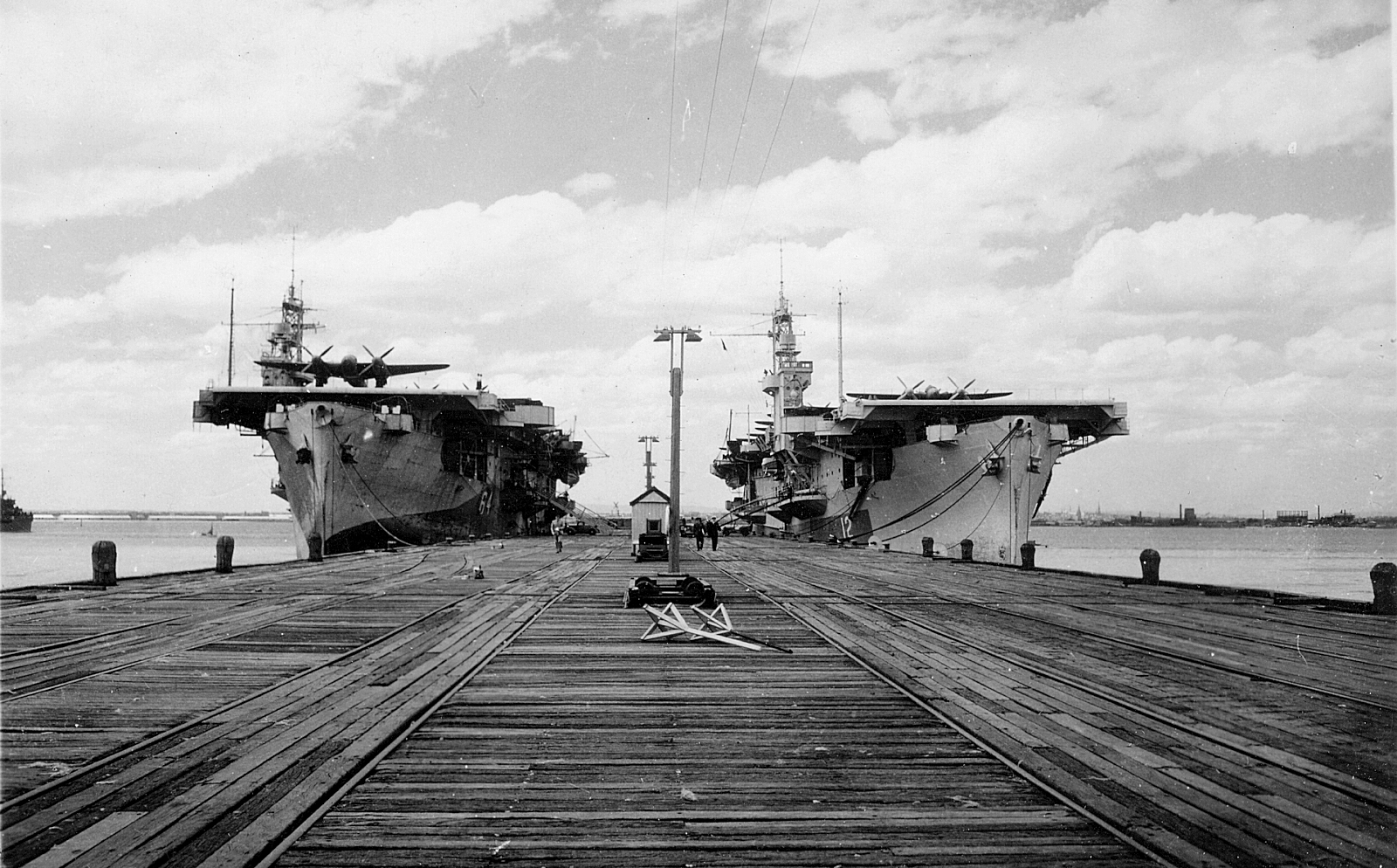 |
Alongside at Williamstown, Victoria, FENCER (Left)
&STRIKER (Right) wait to unload the men and aircraft
of 618 squadron RAF before proceeding on to Sydney were
they were assigned to 30 ACS, as part of the Fleet Train
of the British Pacific Fleet.. Photo: Richard Webb |
A dedicated Ferry Carrier
After unloading at Sydney FENCER was to be employed as a dedicated ferry carrier, she sailed almost straightaway for India to collect her first load, embarking aircraft at
RNAS Cochin on January 28th. On arrival back in Australia her ferry load was disembarked
RNAS Bankstown, Sydney and she made a second run to Cochin, embarking another ferry load on February 28th.
This time after unloading at Sydney she embarked a ferry load of aircraft for delivery to the Maintenance Carrier
UNICORN at San Pedro bay, Leyte in the Philippines, the location of the Fleet Trains forward base. FENCER sailed from Sydney on March 31st and arrived at San Pedro Bay at 098:00 on April 10th.
She remained at Leyte for the next two weeks, sailing for Manus on April 26th. She called at Hollandia, New Guinea April 29th before arriving at Manus on the 30th. This was short stopover, she sailed for Sydney on May 1st.
Reallocated to 21 ACS in East Indies Fleet after refit in South Africa:
June 1945
On completion of her duty as a Fleet Train ferry carrier FENCER was assessed for her refit needs on her arrival back at Sydney, with particular attention being given to her close in defensive armament. She was to be reallocated for service the
21st Aircraft Carrier Squadron, part of the
East Indies Fleet, and new squadron would be allocated on her arrival on station.
Her refit was to be carried by the RN Dockyard at Simon's Town, South Africa
And she sailed from Sydney on June 13th. The carrier was docked at the Selborne dry dock at Simon's Town July 9-11th. By the time she had completed her post refit shakedown and arrived at Trincomalee the war was over and she was nominated for return to the UK for conversion to a Troop Ship.
FENCER sailed from Ceylon on September 4th 1945, carrying passengers and equipment for return to the UK. She arrived on the Clyde on September 25th and was allocated to a commercial Dockyard in London for her conversion work to be carried out and
sailed for the Thames on September 30th.
Conversion for duty as a troop ship November – December 1945
FENCER was one of 6 CVEs to be converted for Trooping, along with
ATHELING,
PATROLLER,
QUEEN,
RAJAH, and
RANEE. For Trooping these vessels were outfitted to carry approximately 60 officers and 1,000 ratings in addition to a reduced crew of about 250. FENCER’s conversion was estimated to cost £17,766.
The main work consisted of converting the
hangar deck into accommodation spaces; 684 bunks and kit lockers were
installed along with providing a dining hall in hangar with tables and
seating for 240 men. Additional Heads and washing facilities were installed by converting several spaces, including the torpedo workshops, pyrotechnics locker, aircraft and Boat engine workshop and aft lift well spaces. Corticene (a form of Limonium) wise laid in all gangways, the dining hall and the berthing spaces in the in hangar for improved footing. Additional equipment was also installed in the main galley and Wardroom galley to cater for the increased numbers to be fed (three and a half times her wartime complement). Several petrol tanks were converted to provide additional fresh water.
The ship was also to be tropicalised as far as possible in the time available, mainly by providing improved ventilation in the hangar deck and engine room; much of the work had already been competed on previous refits. Additional lifesaving equipment, sufficient for evacuation of all on board was provided by installing banks of extra Carley Floats on the Flight Deck. For good order and discipline part of compartment A.104E – forward of Frame 47 was converted into a Guard Room with four cells.
|
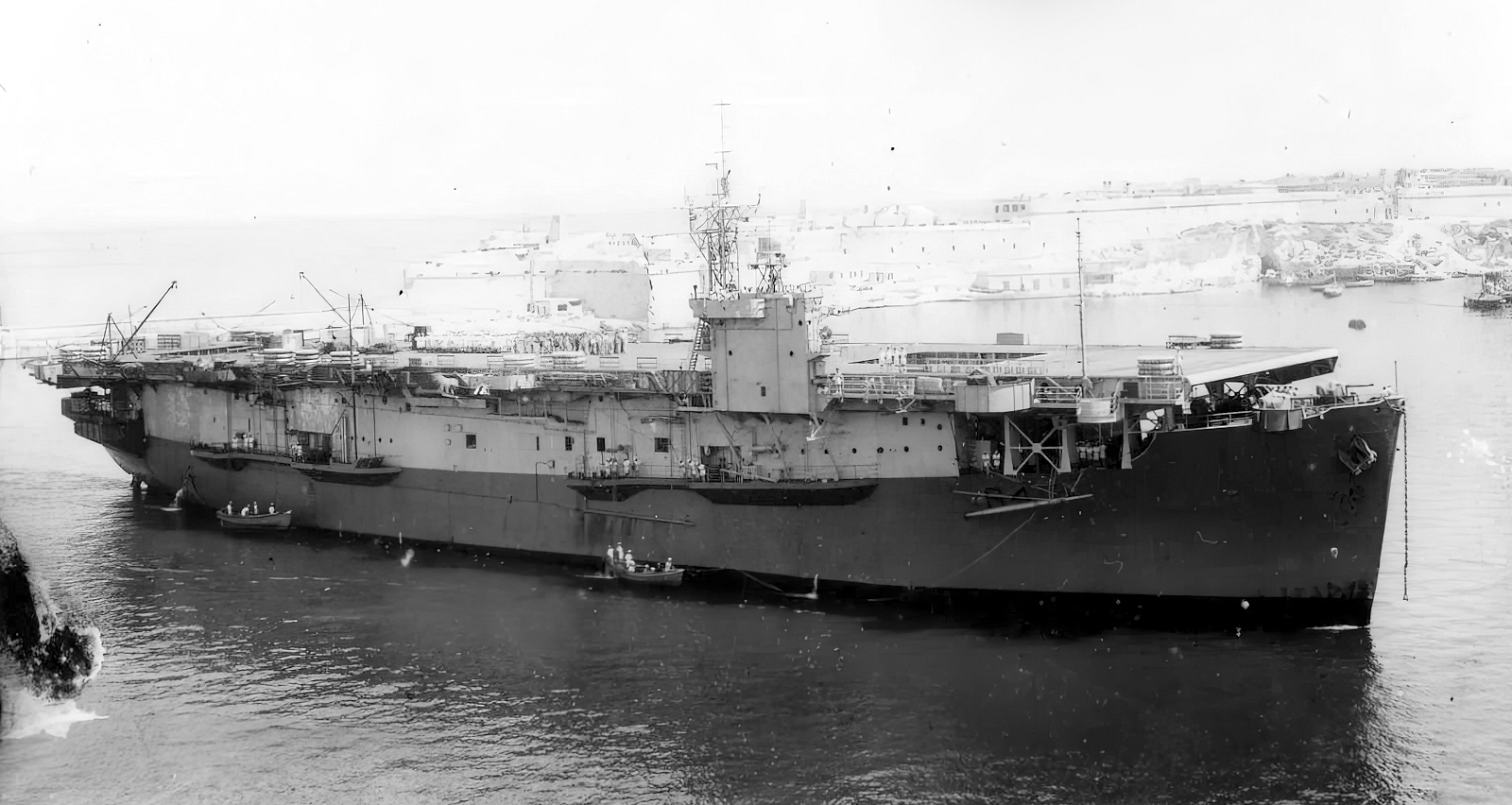 |
FENCER enters Grand Harbour, Malta during on of
her trooping voyages in 1946. |
First trooping run : FENCER sailed from the UK on December 11th 1945 for Colombo carrying Naval Drafts and civilian passengers, including a number of White Fathers missionaries going to Mombasa, Kenya to re-establish their ministry there after the war. She arrived back in the UK on February 21st 1946.
Second trooping run: She sailed again on March 14th, another run to Colombo. Arriving back on May 3rd.
Third trooping run: After a quick turnaround she sailed on her last trip to Ceylon on May 20th, arriving back on July 18th.
Fourth trooping run: Her final dedicated trooping voyage departed from Chatham on August 10th calling at Gibraltar, Malta, and Port Said arriving back in the UK on September 12th 1946.
Disposal: Return to US Custody
FENCER was destored and all Admiralty equipment was removed in preparation for her return to the US Navy. She sailed from the UK on October 22nd for Norfolk, Virginia, calling at Bermuda to deliver passengers, arriving at Norfolk on November 8th 1946. She was decommissioned and returned to US custody on November 21st. She was later stricken from the US Navy register and put up for disposal. She was sold for conversion into mercantile service in December 1947.
Purchased by Flotta Lauro Lines (along with sister ship ATHELING) she was converted in Naples, Italy into a passenger/cargo liner for use as an Emigrant ship. FENCER was renamed SS SYDNEY, ATHELING became SS ROMA. They emerged from conversion with first class passenger’s accommodation on two of the superstructure decks, while tourist class had three decks below. Two cargos holds forward and one aft. Initally each ship could carry 92 first and 680 Tourist Class passengers.
Based in Genoa ROMA made her maiden voyage in August 1951 followed by SYDNEY in September. Both ships served the Italy to Australia route, Genoa to Fremantle, continuing to Melbourne and Sydney; travelling north to Brisbane before returning to Genoa. SS SYDNEY was sold late in 1969 to ‘Aretusa SpA di Nav’ but shewas laid up well into 1970 before she was sold again, that same year to ‘Sovereign Cruises’. She was sold her again in 1971 to ‘Mediterranean Cruises’ and was renamed GALAXY QUEEN. In 1972 she was sold to ‘G Koszovillis’ who renamed her LADY DINA, and finally in 1973 she was sold to ‘Marimina Shipping Co. Sa.’ who renamed her CARIBIA 2. In 1974 she was sold to Italian ship breakers ‘Terrestre Marittima’. La Spezia and CARIBIA 2 was scrapped beginning in September 1975.
|
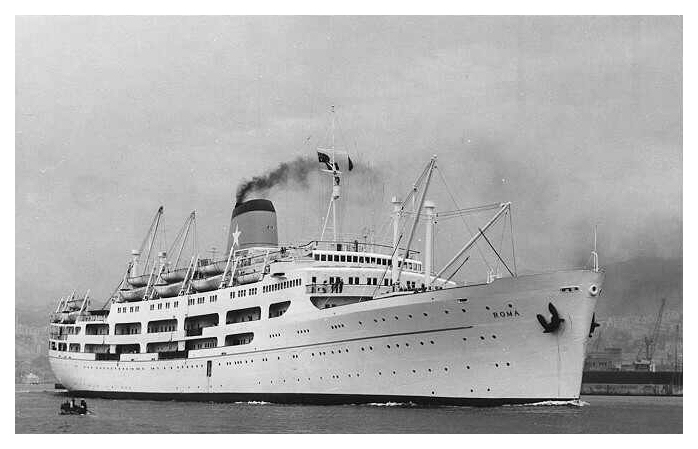 |
The S.S. ROMA (formerly SYDNEY). |
Content revised:
04 April 2022
Sources used in compiling this account:
Click here for a list of
Primary sources
Additional sources:
Fold3.com various documents including;
Admiralty War Diaries
Norfolk Navy Yard War Diaries
Mew York Navy Yard War Diaries
Miscellaneous documents
|
Home
page |
go to the top
|
Comments (3)
My Grandparents sailed to Europe on the "Roma", i still have the passenger list